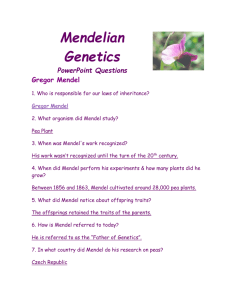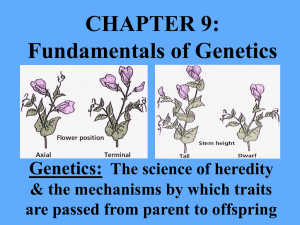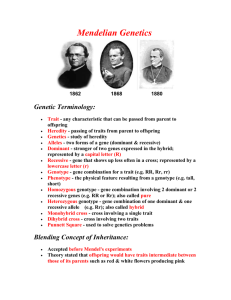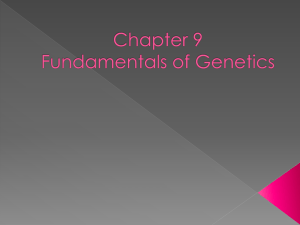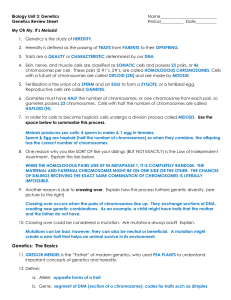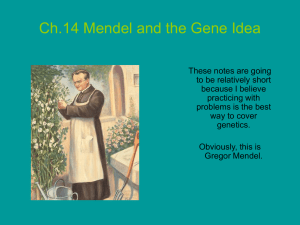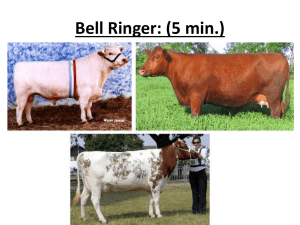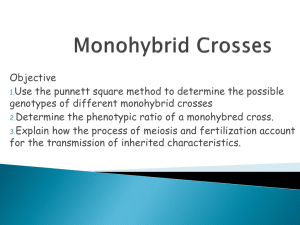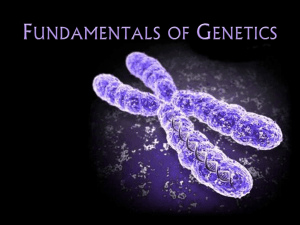PowerPoint
advertisement
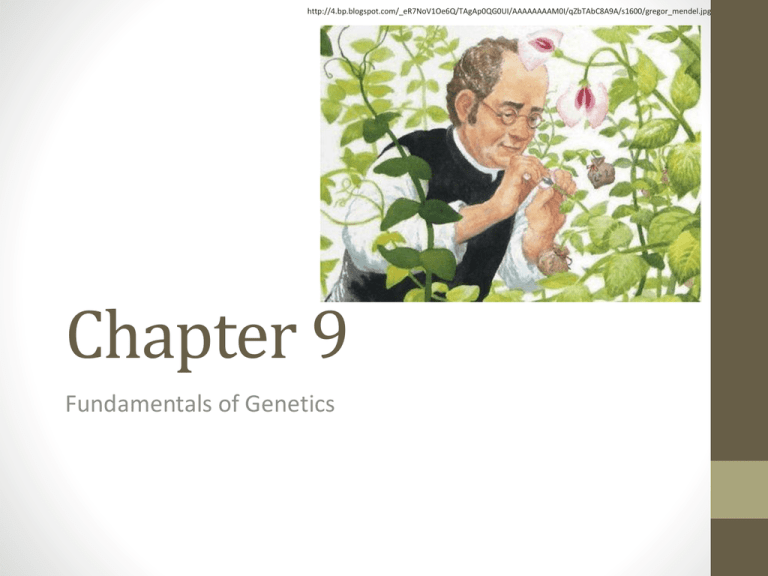
http://4.bp.blogspot.com/_eR7NoV1Oe6Q/TAgAp0QG0UI/AAAAAAAAM0I/qZbTAbC8A9A/s1600/gregor_mendel.jpg Chapter 9 Fundamentals of Genetics Section 1 Vocabulary Pretest • Genetics • Heredity • Trait • Pollination • Self-pollination • Cross-pollination • True-breeding • P generation • F1 generation • F2 generation A. B. Variant of a characteristic Transfer of pollen from anther to stigma C. Study of how traits are passed from parents to offspring D. Parent generation E. Passing of traits from parents to offspring F. First filial generation G. Pollination between two different plants H. Second filial generation I. Pollination of one flower or flowers on the same plant J. Pure plants (for a particular trait) • Dominant • Recessive • Law of Segregation • Law of Independent Assortment • Molecular Genetics • Allele K. Alternate forms of a gene L. Allele that is expressed when only one is present M. Allele that can be hidden N. Pair of alleles is separated during meiosis O. Study of the structure and function of genes and chromosome P. Alleles in a pair separate independently of one another Answer Key • • • • • • • • • • Genetics Heredity Trait Pollination Self-pollination Cross-pollination True-breeding P generation F1 generation F2 generation C E A B I G J D F H Dominant Recessive Law of Segregation Law of Independent Assort. Molecular Genetics Allele L M N P O K Genetics • Genetics is the study of how traits are passed from parents to offspring. • Heredity is the actual passing of traits from parents to offspring. • Thus, Genetics is the study of heredity. • A Trait is a genetically determined variant of a characteristic • Example: yellow flower http://www.fiftyflowers.com/site_files/FiftyFlowers/Image/Pro duct/Yellow_French_Tulip_Flower_250.jpg Gregor Mendel • Gregor Mendel is known as the father of modern genetics. • Mendel was an Austrian monk born in 1822. • Experimented with garden pea plants (Pisum sativum) • Presented the first paper on genetic research titled, “Experiments with Plant Hybrids” in 1866. http://www.nndb.com/people/015/000083763/mendel-1-sized.jpg Why Pea Plants? • Pea plants usually self pollinate, producing pure plants. • Mendel found a way to easily cross pollinate plants, allowing him to select parent plants. • Easy to grow large numbers of plants, making his experiments statistically valid. • Many different traits could be studied. http://mac122.icu.ac.jp/gen-ed/mendel-gifs/18-mendel-cartoon.JPG • Mendel studied 7 characteristics: and 14 observable traits • Plant height: • tall and short • Flower position: • axial and terminal • Pod color: • green and yellow • Pod appearance: • smooth and pinched • Seed texture: • round and wrinkled • Seed color: • yellow and green • Flower color: • purple and white http://www.learner.org/interactives/dna/images/genetics2.gif • In all of Mendel’s experiments, he started with truebreeding plants • Produced by allowing plants to self-pollinate for several generations so that they are pure for a trait • Referred to them as the P generation (parent generation) • Then cross-pollinated to get the F1 generation (first filial) • These were allowed to self-pollinate to produce the F2 generation (second filial) http://cooter.k12.mo.us/MrWalls/Bio2/chapter%209%20Mendel/Chapter%209%20%20Genetics%20Notes_files/image007.jpg • Mendel obtained truebreeding plants for all 14 traits observed. He did hundreds of crosses and documented the results. • Patterns began to emerge: • Only one of the two traits appeared in the F1 generation • What happened to the other trait? • The second trait reappeared in the F2 generation • The ratio was approximately 3 of the first trait to 1 of the second. (3:1) Dominant and Recessive Alleles • Mendel concluded that the traits were controlled by “factors” passed down from parent plants. • We now call these factors “alleles” • Alleles can be either dominant or recessive • Dominant alleles can mask or hide alleles for other traits. Use capital letters to represent them. • Recessive alleles can be hidden by alleles for other traits. Use lower case letters to represent them. • All the traits seen in the F1 generations were dominant • All the traits that reappeared in the F2 generations were recessive. Mendel’s Laws • Law of Segregation —states that a pair of alleles is separated during the formation of gametes. http://www.tutorvista.com/selfstudy/?id_course=59&id_lo=19194 • Law of Independent Assortment —factors for individual characteristics are not necessarily connected (unless they are carried on the same chromosome). Therefore, they separate independently of one another during the formation of gametes. http://www.liftminds.com/docs/saver3/Biology/Inheritancepattern/Inherit006_files/image001.Jpg Section 2 Vocabulary Pretest • • • • • • • • • • Genotype Phenotype Homozygous Heterozygous Probability Monohybrid Cross Punnett Square Genotypic Ratio Phenotypic Ratio Dihybrid Cross A. An organism’s genetic make-up (letter code) B. Two alleles are different C. Two alleles are same D. Tool for predicting the outcome of a particular cross E. An organism’s appearance (word description) F. Likelihood that an event will occur G. A cross with only one characteristic H. 1BB : 2Bb : 1bb I. A cross with two characteristics J. 3 Black : 1 Brown • Testcross • Complete Dominance • Incomplete Dominance • Codominance K. Both alleles for a gene are expressed in a heterozygous offspring L. One allele completely hides another M. Phenotype is intermediate of the parents (blending) N. Cross an unknown dominant with a homozygous recessive Answer Key • • • • • • • • • • • • • • Genotype Phenotype Homozygous Heterozygous Probability Monohybrid Cross Punnett Square Genotypic Ratio Phenotypic Ratio Dihybrid Cross Testcross Complete Dominance Incomplete Dominance Codominance A E C B F G D H J I N L M K Phenotype and Genotype • Phenotype —an organism’s appearance (word description) • Phenotype for flower color: Purple or White • Genotype —an organism’s genetic make-up (letter code) • Genotype for purple flowers: PP or Pp • Genotype for white flowers: http://www.nicerweb.com/bio1151/ Locked/media/ch14/14_06Phenotyp eVsGenotype_L.jpg pp Homozygous and Heterozygous • Homozygous —both alleles of a pair are alike (also called pure) • Homozygous white = pp • Homozygous purple = PP • Heterozygous —two alleles in a pair are different (also called hybrid) • Heterozygous purple = Pp Probability • Probability is the likelihood that a specific event will occur. • Probability is calculated by the following equation: Probability = # of times an event is expected to happen # of times an event could happen Ex: Mendel grew 705 purple plants and 224 white plants. What is the probability that a purple plant will appear in a similar cross? 705 = 0.75 929 Probability can be expressed as: a percent 75% a fraction ¾ or a ratio 3 : 1 Monohybrid Crosses • Monohybrid Crosses —only one characteristic is tracked • A tool used to predict the outcome of different types of monohybrid crosses is called a Punnett Square • Named for Reginald Punnett • Example: TT x tt (Pure tall plants x Pure short plants) t t T T Tt Tt Tt Tt Result: 100% Heterozygous tall offspring Genotype = Tt Phenotype = tall • Example: Tt x Tt T T t (Hybrid tall X Hybrid tall) t TT Tt Tt tt TT = 25% 1/4 Tt = 50% 2/4 tt = 25% 1/4 Genotypic Ratio: 1 TT : 2 Tt : 1 tt Phenotypic Ratio: 3 tall : 1 Short A testcross is performed when you are not sure if an organism showing a dominant trait is heterozygous or homozygous for the trait. To find out, it is crossed with a homozygous recessive If even one recessive individual appears, then the unknown was heterozygous. http://proctornet.com/text/chapter10/10images/10-06.gif Incomplete Dominance • Incomplete Dominance occurs when offspring have a phenotype that is in between that of the two parents. RR Rr http://smabiology.blogspot.com/2008_11_01_archive.html rr • Punnett Squares for incomplete dominance are completed in the same manner. Except that the heterozygous individuals will have the blended phenotype. • Example: Pink Flower x Pink Flower Rr x Rr R r R RR Rr r Rr rr Results: 25% Red flowers 50% Pink flowers 25% White flowers Genotypic Ratio: 1 RR : 2 Rr : 1 rr Phenotypic Ratio: 1 Red : 2 Pink : 1 White Codominance • Codominance occurs when both alleles in a pair are expressed but do not actually blend. • Human Blood Type is an example of codominance. • Three alleles (A,B and O) are involved in determining blood type. However, you still only inherit two (one from mom and one from dad) • A and B are both dominant; O is recessive • Type AB blood has one genotype: AB (both alleles are expressed and blood cells will have both A and B antigens on them) • Type A blood has two possible genotypes: AA and AO • Type B blood has two possible genotypes: BB and BO • Type O blood has only one possible genotype: OO Dihybrid Crosses • Dihybrid Cross --shows two traits at the same time. • Example: RrYy x RrYy (heterozygous round and yellow seeds) R = round r = wrinkled Y = yellow y = green RY Ry rY ry RY RRYY RRYy RrYY RrYy Ry RRYy RRyy RrYy rY RrYY RrYy rrYY Rryy ry RrYy Rryy rryy rrYy rrYy Results: 9 round/yellow 3 round/green 3 wrinkled/yellow 1 wrinkled/green

